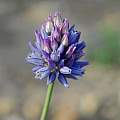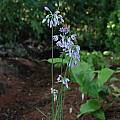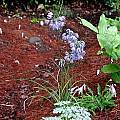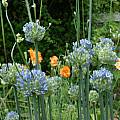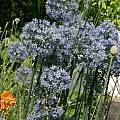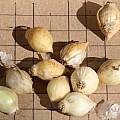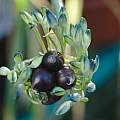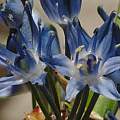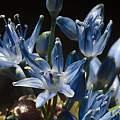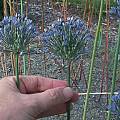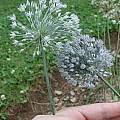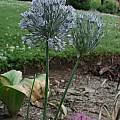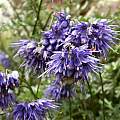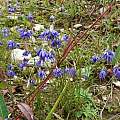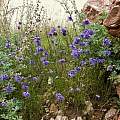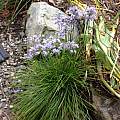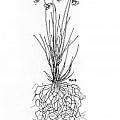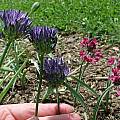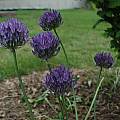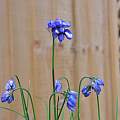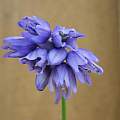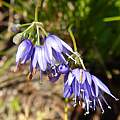Much admired are the blue alliums, although like many alliums, they're terribly confused in horticultural circles. The species that bloom mid to late summer, such as A. cyaneum, A. sikkimense and A. beesianum, are particularly valued for their late color and delicate flowers in various shades of true blue. This is a small group, with only 17 species out of 850 species having true blue flower coloration.
Allium ascalonicum syn. Allium hierochuntinum is the only blue flowering Allium in the eastern Mediterranean. This small, slender species grows in the deserts of Syria south to Egypt and Saudi Arabia, flowering in March. Photo was taken in north east Jordan by Oron Peri.
Allium beesianum W.W.Sm. is a Chinese species, and one of the few true blue flowered Allium species. This late summer blooming allium is often confused with Allium sikkimense. The latter flowers in July whereas A. beesianum flowers in late August to September. Arthur Kilpin Bulley (1861-1942) was a rich cotton merchant from Cheshire who founded the company Bees Seeds and employed some of the famous plant hunters and this is where the name derives from. Classification of the plant in 1914 is credited to the Scottish botanist Sir William Wright Smith (1875-1956). It is found in SW. Sichuan and NW. Yunnan. Photos by Mark McDonough, taken August 23, 2002 and one week later on Aug. 31st, with more flowers open and foliage showing:
Allium caeruleum Pall. (syn. Allium azureum Ledeb.) is readily available, inexpensive, free flowering and very pretty in the garden. Its native range is from eastern Europe to China. This species, here photographed in the Maryland, USA garden of Jim McKenney in early June 2005, seems to require dry summers to persist from year to year. As the plants get older, the umbels tend to become irregular and bulbiferous. But the wonderful color does not change. The orange flower seen in one of the photographs is the perennial poppy variously known as Papaver atlanticum or P. rupifragum. The poppy and the blue onion make a cheery late spring combination. Photo 3 by M.Gastil-Buhl shows bulbs on a 1 cm grid. Photo 4 by David Pilling displays bulbils in the flower head.
Allium caesium Schrenk - a deep blue form from Antoine Hoog. This Central Asian species is variable and occurs in a number of different forms and shades of blue. Previously I have grown a soft gray-blue form, but the dark blue form shown in the first picture is also attractive, flowering in early summer. The next two photos illustrate two more forms, collected from Central Asia by Arnis Seisums, showing the variability of the species. The flower heads are large and a beautiful pale yet rich milky blue color. Both photos taken in June 2004. All photos by Mark McDonough.
Allium cyaneum Regel is a dwarf, mid to late summer flowering blue allium from China. It is extremely variable, but typically a small plant 6" or less in height, with fine grassy foliage, and small pendant to semi-erect sprays of starry blue flowers, variable in color from pale grayish blue to deep cobalt blue. Albino forms are known but rare. The first three photos from iNaturalist were taken by Leoš Smutný in China in July and shared under a CC BY-NC license. The fourth photograph was taken by Rimmer de Vries who comments: "this is typically offered as an impostor for Allium beesianum, but has super fine grass-like foliage, is shorter, blooms later and the stamens extend beyond the tepals". The last image is a drawing by Mark McDonough.
Allium litvinovii Drobow ex Vved. - From Central Asia, this is a rare species only recently introduced into cultivation. It's available from Pacific Rim Native Plant Nursery, and well worth the price, if it's still available. The collection data is given as Kirghizstan, Chatkal Range, near Lake Sari-Chilek. It flowers in May-June with large, intensely purple-blue balls of bloom, atop 16" (40 cm) stems. Reportedly allied to A. caesium Schrenk and A. caeruleum Pall., it is distinctive in both flower and foliage. The first photo is in early anthesis, the 2nd shot at full anthesis. Photos by Mark McDonough.
Allium sikkimense Baker (syn. Allium cyaneum var. brachystemon Regel, Allium kansuense Regel, Allium tibeticum Rendle) is an Asian species native to Tibet, China, and into India, closely allied to A. beesianum W.W.Sm. Striking blue flowers with hooded nectaries top 5 to 40 cm scapes. The bulbs are clustered and cylindrical, with dark brown tunics, reticulated at the base. Grows in forest margins, scrub, slopes, and meadows from 2400-5000 m. See a full description on the Flora of China of Allium sikkimense. Photos 1 and 2 by RH of plants grown from AGS seed. Photo 3 by Kathleen Sayce.
Allium index -All alliums - Allium flavum Relatives - American alliums A-F - American alliums G-Z - Big Ball alliums - Chives - Domed alliums - Drumstick alliums - Rhizomatous alliums
